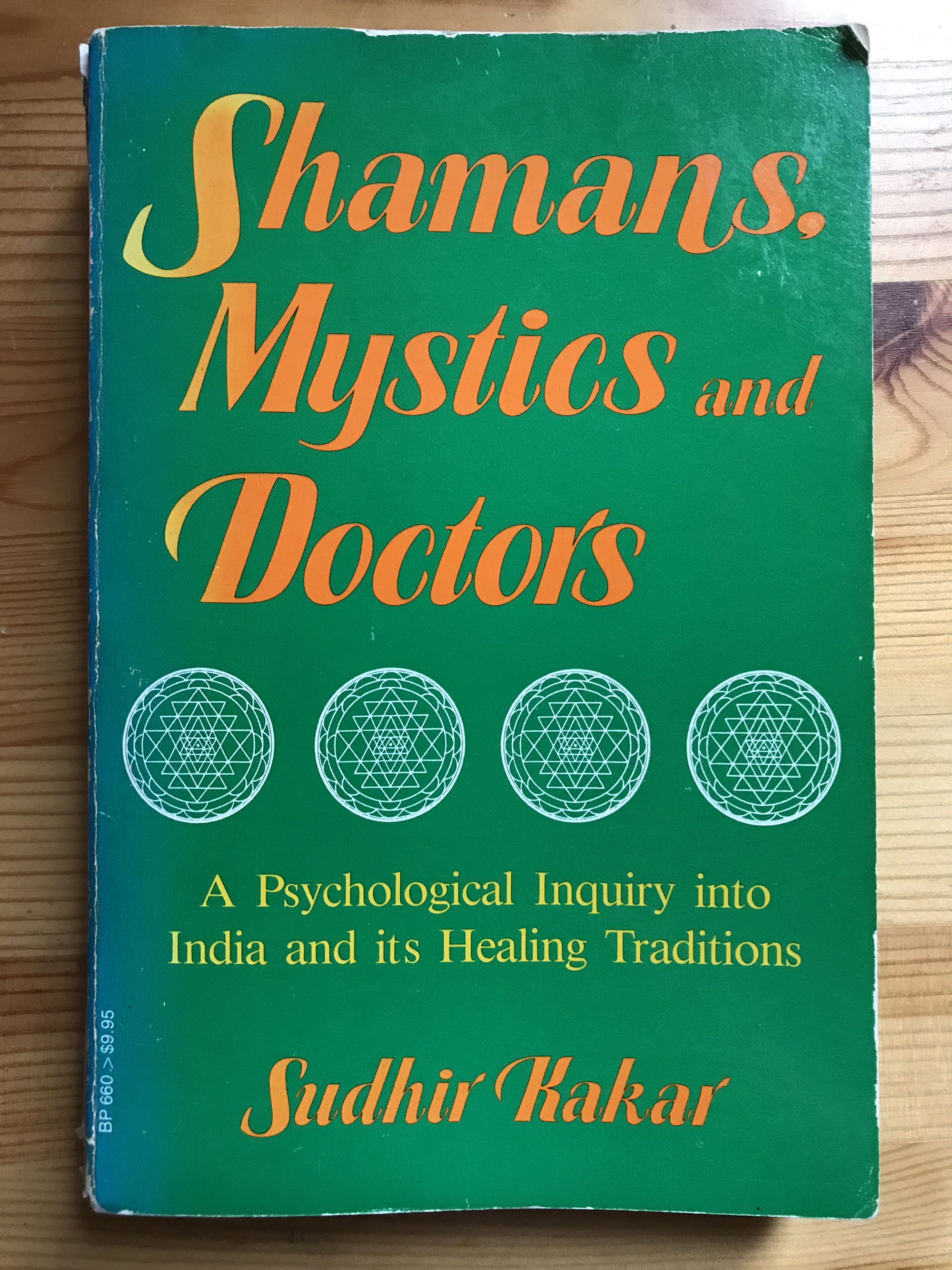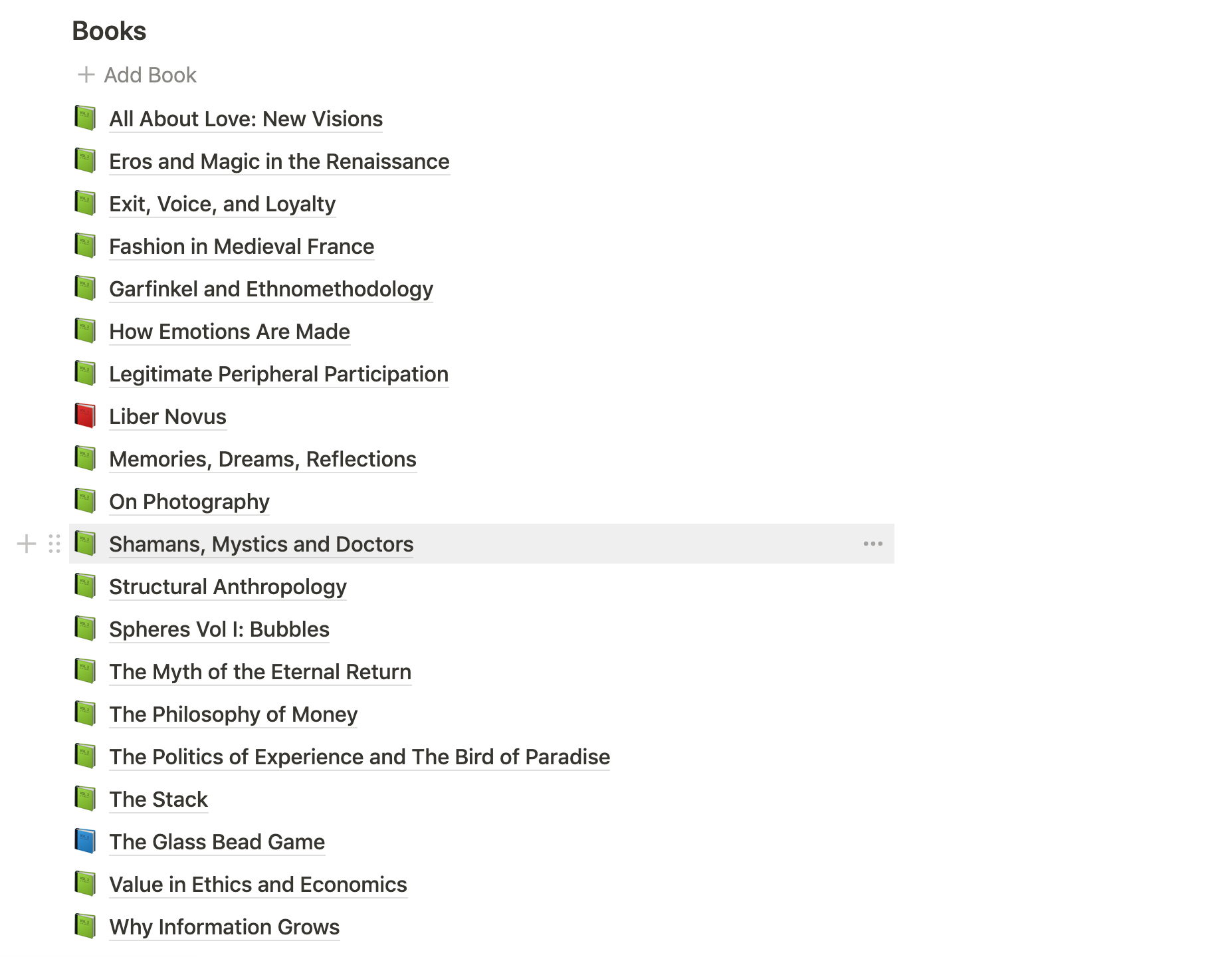
While taking a break from writing on a short retreat, I scanned a low bookshelf for interesting titles left by the home’s previous owner. I promised myself I’d read Nietzsche this year. No luck. This green spine stood out to me though. I can’t remember now—was it the title that drew me? Or did its color afford to me that it would fit neatly within my other non-fiction readings? I picked it up off the shelf.

Shamans, Mystics, and Doctors (1982) turned out to be a valiant anthropological effort detailing several years of field studies on healing traditions in India, conducted by noted Indian psychoanalyst Sudhir Kakar. As the title suggests, the author visits three categories of healing:
- Shamanic and folk healing traditions, which deal primarily with the expulsion of possessing demons.
- Mystical traditions, including various guru-disciple relationships and tantric healing.
- Ayurveda, or traditional Indian medicine and psychiatry.
As I myself have had no prior exposure to Indian healing practices and systems of thought, and have a basic but limited understanding of Western psychological history, I appreciated Kakar’s approach to this book. His method is to engage wholeheartedly with the practices he encounters, then to attempt to reconcile them with his psychoanalytic understanding of the same situation. While I occasionally found his comparisons strained, especially in his preference for classical psychoanalysis, overall Kakar navigates the cultural divide with tact, good humor, and self-awareness. In the introduction, he writes: “The contradiction in simultaneously pursuing cultural relativity and psychological universalism, looking at the healing phenomena first in cultural terms and then in psychoanalytic ones, is evident.” It is this contradiction that provides the most intellectually stimulating moments of the book.
I want to reproduce two of the moments of tension I found most interesting, along with some of my notes. Few conclusions, many questions, blog style.
In the first part of the book, Kakar explores traditions in which (what we understand as) psychological conflicts are imputed to malicious demons and spirits which possess the patient. I want to reproduce an entire section, emphasis mine. Kakar’s first reference here is to anthropologist Lévi-Strauss’s famous analysis of a healing ritual song performed by a shaman during a difficult childbirth, from his essay The Effectiveness of Symbols. Note that Lévi-Strauss’s interpretation that the healing is purely symbolic has been disputed for several reasons, one being that a full version of the song suggests that the shaman also applies medications and manual treatment (see Mjönes in further reading).
In drawing some intriguing parallels between shamanism and psychoanalysis, Lévi-Strauss has suggested that whereas a psychoanalytic cure is based upon the patient’s recovery of his individual myth, constructed with elements of his past, the cure in shamanism is predicated on the patient’s receiving the social myth from his collective tradition. The collective myth used by the shaman does not correspond to the patient’s personal state but reintegrates his alienating experience of sickness within a meaningful whole. Both of these myths, whether re-created by the individual or borrowed from tradition, have to be lived or relived by the patient for the healing experience of “abreaction” to take place. Lévi-Strauss further speculated that the contents of the two kinds of myth may be different but their structure, though which the healing symbolic function operated, remained the same. From our studies of Indian shamanic healing, however, it seems premature to assign precedence to form over content. The separation between the use of collective and individual myths in healing is not fundamental but appears to be a matter of relative emphasis and elaboration of the collective versus individual aspects of sickness. The diagnostic and treatment rituals of shamanism—and thus the collective myth which the elaborate—must also offer for the patient an opportunity for “airing” his individual conflict and some kind of resolution on the personal plane. We saw this “airing” of the patient’s personal conflict in the dream communications made to the pir, in the possessing spirit’s exchanges with members of the patient’s family in the exorcism rituals and in the nightly group sessions at Balaji, and in the patient’s exchanges with the possessing spirit and the possessing spirit’s exchanges with the healer in the case of Ayata and other baghats. A successful shamanic ritual is not merely the healing operation of a collective myth subscribed to by the community, but also attends to the individual elements of the patient’s sickness. In some cases, the collective myth used by the shaman clearly addresses the dominant individual conflict in the community—for instance, the sexual anxiety of young Muslim women in the case of the pir and the conflicts around envy among the Oraon in the case of the baghats. In other words, the stock of representations in a collective myth is not a matter of indifference but a potent distillate of the modal conflict experienced by individuals within that community. Conversely, an effective individual resolution of psychic conflict in psychoanalysis and psychoanalytically oriented therapy will, in some measure, also incorporate the collective myth shared by the patient, the therapist, and the community of which they both form a part. Normally, this collective myth, based on the Western tradition of which individual autonomy and individual worth, knowableness of reality and the possibility of real choice are some aspects, remains relatively unarticulated. Nevertheless, as the elaboration of the individual myth proceeds (and this is especially noticeable in psychoanalytic practices across cultures), the collective myth often becomes audible, as a theme here and just a faint echo there, providing the patient with an opportunity to relate and reintegrate his illness with a larger meaningful whole. In contrast to the explanation of two different healing mechanisms (and their ultimate identity) employed by the shaman and the psychoanalyst, I would suggest that both shamanism and psychoanalysis operate within the collective and individual myths, though each chooses to focus on one part of the dual healing mechanism and underplay the other.
In Indian folk healing traditions, one’s community and family play a large role in the therapeutic process. This happens by the recommendation of and accommodation of the patient to the healer, but also participation in the healing experience itself, preparing foods and medicines, accompanying the patient on walks and in consultations, and cohabiting with live-in patients.
The spirit that possesses the patient is also usually sent by a family member—someone deceased at the hand of some difficult fate, or a distant relative or in-law caught in tricky family politics. Kakar sees this, correctly I think, as related to the Western psychoanalysts’s focus on the patient’s relationship to their parents, siblings, and relatives. But the way the family is “brought into” Western psychology and human-centered therapy is quite different.
As opposed to anthropomorphizing it as a devious spirit whose hunger must be sated before it can be banished, the patient herself is assigned responsibility for controlling or changing malfunctioning relation. We categorize and ascribe aspects of our experience to things we call “neuroses,” which we explain as being part of our psyche. Clearly, symbolic manipulation of our unpleasant feelings does not disappear in Western psychology. It just becomes more subtly coded as scientific language and described as a “real part” of the patient. Kakar: “the general Western location of the mind and thus of conscious thought in the head leads to an unavoidable placing of dreams, fantasies, and other psychic activities somewhere “down below” in the body—in the ‘subconscious.’” To take this one step further, Western psychology achieves a merger of the spirits and the self, a conflation which clearly reflects the Western view of causality: man as the primary agent within a world that exists to be tamed by his will—or put inversely, a world bereft of any animating spiritual principle.
This makes me think about the collective myth structure of the Western patient. While the patient’s personal and familial mythos is reliably explored, in my experience, psychotherapy rarely draws attention to the national and cultural mythos. Despite significant variability between community and family systems of meaning, it’s reasonable to expect significant patterns of commonality at the national and cultural level.
Normally, this collective myth, based on the Western tradition of which individual autonomy and individual worth, knowableness of reality and the possibility of real choice are some aspects, remains relatively unarticulated.”
That the “meaningful whole” of Western cultural myth is predicated on a strong individualist liberalism immediately suggests foundational contradictions in the psychotherapeutic process. Americans in particular seem to emphasize the individual aspects of their issues at the expense of relational aspects. Kakar’s cross-cultural analysis of shamanic healing traditions in India reveals that despite “exposing the family members to the patient’s conflict… thus encouraging a realignment of these stressful relationships,” those same practices simultaneously encourage the patient to employ strong defense mechanisms to further repress the internal conflict and reinforce allegiance to the familial network or close collective. Western psychotherapies almost certainly have a similar but converse function that reasserts individualist tendencies, quietly imposed by the higher cultural order both therapists and patients share.
I pondered this as I analyzed aspects of my own mythic stack. One of the most difficult parts of myself to change was my relationship to work. I may not have grown up in a community or family that cared about entrepreneurship, but the media and national character in my teenage years indoctrinated me with the idea that to be valuable, I had to be a self-made entrepreneur type. At the same time, from my family, I learned that I needed to take personal responsibility for things, and that I needed to be recognized as intelligent by others in order to feel valuable. This created a self meaning system that led me to despise lazy, unmotivated, irresponsible, and uninspired people. I punished myself for not working constantly, but had a repressed shadow self that enjoys leisure and a relaxed domestic life. If I had grown up Indian, perhaps I would have been possessed by a demon that left me lethargic and unable to do any work.
My second passage is from part two of the book, on mystical traditions. Here again we see a clear picture of how Western culture views spiritual-psychological phenomena.
Initiation into the Radha Saomi cult undoubtedly restored a sense of well-being to many whose emotional lives had been marked by starkly depressive features. It seems that in most cases the sense of at last being at peace with oneself followed the abandonment of a long and futile struggle to obtain the required supplies of love and esteem from “significant others” in both the outer and inner worlds. The route now taken to restore the self to its pristine glory and powerfulness was very different. The first steps involved a conscious deprecation and a further willed depletion of the self, accompanied by a corresponding idealization of Maharajji. The Satsangi renounced all claims to self-aggrandizement, underlined her or her own unworthiness (“I am not even fit to be the dust on his feet”) and forcefully projected all the positive aspects of the self—its strength, power, knowledge, goodness, gifts, etc.—onto Mahrajji, who became the fount of omniscience and omnipotence. The next step was a sharing of this projected goodness and greatness through “identification,” a psychological process in which Maharajji’s supposed power was assimilated into the self, which was thereby transformed.
… “you are great but I am a part of you.” At the level of manifest behavior, the almost exaggerated humility I encountered in every Satsangi (coupled with his paeans of praise for the master) did not mask the underlying bedrock of a very high self-esteem. Nowhere, it seems, is Nietzsche’s observation that “he who despises himself nevertheless esteems himself thereby as the despiser” more true than in the case of followers of a mystical cult.
The follower is also engaged in an unconscious struggle to deepen the process of idealization and identification.
…
Idealization and identification are certainly not exclusive to the mystical sects, but avowed or unavowed, are also present in most psychotherapies. During certain periods of psychoanalysis, for instance, a patient needs a temporary idealization and identification with the analyst in order to take the initial steps toward self-exploration, which are otherwise prohibited by the archaic and punitive elements of his superego. The difference between the two “healing traditions” lies in the fact that whereas idealization and identification are tactical and temporary in psychoanalysis, they are strategic and intended to be permanent in the Radha Saomi Satsang and other mystical cults.”
…
What psychoanalysts see as the ‘infantilization’ of the seeker and of his search for the ideal parent, the Satsangi will consider as part of the vital surrender to the Master that Maharajji and other gurus demand for a very good reason. . . . Ontogeny is not necessarily a one-way street, and spiritual growth may take a direction opposite to psychological development. Your critical tone, the Satsangi may continue, springs from the Hindu mystic’s affront to your psychoanalytic preference for the model of an individual striving for autonomy and for an increase in the range of his choices in the face of all the inner and outer forces that impinge upon him. For the Hindu, however, boundaries are obstacles, the body is a prison, autonomy a curse. Gaining irreversible insights into the events of one’s mental life is not the only way to “maturity,” the Satsangi may further argue, for one can detach oneself from one’s biography by following the mystical path. Such a detachment is not defensive but a “virtue”—particularly of middle age—which the mystical way and the guru can help you cultivate.
When put into the relief of an Indian cultural backdrop, the defense mechanisms and harmful “neuroses” of the West appear to be evolutionarily adaptive behaviors. What we call psychological functions like idealization, identification, and abreaction are at their core varieties of magical thinking. Of course, even if we are aware of projection, we can’t fully avoid it—we are projecting all the time. Yet in therapy, we actively and self-consciously deconstruct projections. What does it mean that we relativize this evolved psychological capability by revealing it as such?
This steady persecution of magical thinking is quite relevant to what I brought up earlier: Western thought’s lack of an animating principle for the world. I learned about Charles Taylor’s book The Secular Age from L.M. Sacasas, who blogs regularly on this topic at The Frailest Thing. In this book, Taylor makes the case that the modern world is undergoing a process of de-animation (delamination?) that he calls disenchantment. The premodern or enchanted world, things and spirits external to humans impose meaning, have agency, and possess causal power, whereas in modernity humans view themselves as the exclusive, even rightful holders of agency. Sacasas summarizes that “belief in the magical/mystical may persist, but its role in shaping our tacit understanding of the world will be altered or diminished. It will, for one thing, become newly conscious of itself, and, to the degree that it is, it will tend to undermine its own experiential integrity” (emphasis mine).
Ironically, psychology remains one of the closest things we have to a mainstream magic or a mystical art today. Not only is it plainly the direct descendent of medieval magic, as I learned when I read Ioan Coulianou’s Eros and Magic in the Renaissance earlier this year. It is a theory of the self that is phenomenologically accurate, objectively wrong, and is based on magical thinking even as it deconstructs itself. Some magical thinking processes that happen in psychotherapy, such as transference to the psychologist, are even intended to stay unmentioned to the patient in order to be utilized most effectively by the therapist! Like sorcerers hiding their secrets. On the topic of its objective wrongness: much of the language of psychology is over a century old, and cutting edge neuroscientific accounts of the brain still struggle to explain dreams and this thing we call the unconscious. Yet despite its many obvious wrongnesses, psychology frequently (but not always) works. Lévi-Strauss may be right that the healing it offers is largely a symbolic function. At least for many people, it’s a powerful map of the self. In terms of collective buy-in as a method of self-transformation, psychology far surpasses other systems of meaning such as astrology (more of a toy than a religion) or niche new-age beliefs.
As the Western(ized) world’s demand for meaning is becoming more urgent and signs of crisis run rampant, I wonder which aspects of Western metaphysics will stay with us, and which will get transformed in the reckoning. Liberal individualism is a very new cultural innovation. I’m not sure it will last. My own experience of growth whispers to me that a more nuanced, more full, more open relationality might relieve the Western self from its deepest fears and defenses. A couple months ago my friend Laurel and I held a workshop on group relational practices that happen in circles for our friends. At the end, the overwhelming sentiment of participants was that more spaces for more experimental ways of relating and sharing are needed. But at this level of praxis can cultural change outpace the demands of shareholder value?

A few people I know are interested in re-animating the world. It doesn’t look like a trivial task. Some others think that technological complexity will do the job, imbuing the networked world with an agency beyond our comprehension. A long bet, in the range of two or three centuries I think. Neither paths seem reasonable; both require a leap of faith. From our current vantage point, seeing everything in the world as meaningful is the precise definition of madness. But where the incomprehensible and the unreasonable are brought together the magical may proceed.
Books I just finished:
- Shamans, Mystics, and Doctors, Sudhir Kakar
- Of Water and the Spirit, Malidoma Patrice Some
Books I am reading:
- Bubbles, Peter Sloterdijk
- On Becoming a Person, Carl Rogers
Reading soon:
- The Origin of Concepts, Susan Carey
Visiting soon:
- Austin
- Berlin
Interested in learning more about:
- Disenchantment
Interested in experiencing:
- Re-enchantment
Connecting the Dots on American Psychology
The terrain of American mental health is as vast and colorful as this country’s geography. I’ve been interested in exploring the landscape since 2019, when I dashed off a quick blog post on cultural differences in psychology. Backburnered for four years, the topic is now top of mind for me. My interest in the economies of cultural and spiritual production,…
